|
|
|
Sort Order |
|
|
|
Items / Page
|
|
|
|
|
|
|
| Srl | Item |
| 1 |
ID:
163889
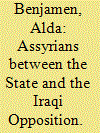

|
|
|
| 2 |
ID:
162679


|
|
|
|
|
| Summary/Abstract |
Recent alleged uses of chemical weapons in Syria and Iraq have led to a renewed interest in the topic. The starting point for modern chemical warfare is World War I, of which much has been written. Interestingly, many of the cases of chemical warfare after that war and prior to World War II are not as fully fleshed out as one might expect, since the most recent case was over seventy-five years ago. This study looks at evidence on cases of chemical warfare from 1919 to 1939 to ask what we know about those cases and what remains to be answered. This period, bookended by the birth of modern chemical warfare and the widely noted pattern of non-use during World War II, was a time of uncertainty about whether and how the production and use of chemical weapons might spread. A number of cases, both those generally accepted and those more contentious, are reviewed, and a few common themes are teased out in the final section of the study. In particular, the norm against chemical weapons during these two decades appeared to be limited to the view that states would generally refrain from being the first to use chemical weapons against European, particularly possessor, states, but in other conflicts the employment of such weapons was at least considered, and occasionally carried out. Many information gaps remain, and it is hoped that the descriptions of the cases will encourage others to carry out further research.
|
|
|
|
|
|
|
|
|
|
|
|
|
|
|
|
| 3 |
ID:
188403
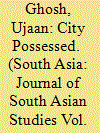

|
|
|
|
|
| Summary/Abstract |
The mid twentieth-century Bengali ghost story has a distinct urban form. From haunting Gothic mansions, ominous bungalows and thickets of trees, the ghosts of mid twentieth-century fiction show up in the streets of Calcutta, on motorised omnibuses, in urban movie theatres and even selling cocaine in the docks of the city. In this paper, I explore why Bengali ghost stories in the twentieth century predominantly choose the city as a motif to situate their hauntings. I analyse two spectral texts from the mid twentieth century, ‘Kankal Sarathi (The Skeleton Chauffeur)’ by Hemendra Kumar Ray (1888–1963) and ‘Andhakre (In Darkness)’ by Sharadindu Bandyopadhyay (1899–1970), and juxtapose them alongside the official urban archive. Significant changes took place in Calcutta’s urban planning at the turn of the twentieth century. Committed to ‘improving’ the city, planners sought large-scale demolitions of existing buildings, which resulted in massive displacement of individuals and communities. Historians have recorded the deep disquiet these changes induced in the city’s inhabitants. What I demonstrate are the ways in which ghost stories responded to these infrastructural alterities. Spectral narratives emerged as a new literary strategy through which the city’s new journey towards infrastructural modernity was critiqued. The larger methodological question I wish to explore is whether it is possible to treat the genre of horror as an extended archive of historical inquiry.
|
|
|
|
|
|
|
|
|
|
|
|
|
|
|
|
| 4 |
ID:
134447
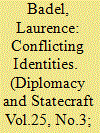

|
|
|
|
|
| Summary/Abstract |
The question of diplomatic identity has rarely seen study from a specifically historical perspective rooted in the long term. This analysis explores the role and self-perceptions of an unknown and, yet, central actor in the French economic diplomacy: the commercial counsellor. It offers new and stimulating ideas on the entangled links between State and the business sphere in France. The fundamental ambivalence of the commercial counsellor’s identity illuminates the atypical nature of French commercial diplomacy from 1918 to the 2000s. Through assimilation into the Ministry of Economy and in a Janus-like role facing both the Quai d’Orsay and French companies, French commercial counsellors have had to endure a complicated situation whilst remaining the Cinderella of the diplomatic sphere. Deploying an historical analysis to enrich the contemporary debate on the state of diplomacy, this study explores the impact of interventions by non-state actors at the heart of the diplomatic machinery. Far from being an innovation of the 1990s, this intervention was a recurring theme throughout the twentieth century, and its examination sheds new light on the persistence of the neo-corporatist practice of commercial diplomacy in France.
|
|
|
|
|
|
|
|
|
|
|
|
|
|
|
|
| 5 |
ID:
183373
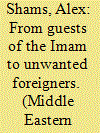

|
|
|
|
|
| Summary/Abstract |
Until the 1930s, Mashhad, Iran received thousands of pilgrims from South Asia yearly, a central node in the Shiʿi shrine city network spanning the Persianate world. Within decades, South Asian pilgrims had all but disappeared from Iran. This article examines how Reza Shah’s drive to ‘nationalize’ Iran spelled the end for this transregional network, leading to harassment of South Asians, increasingly seen not as ‘guests of the Imam’ but as foreigners tied to British colonialism. These decrees included dress codes that banned turbans and veiling, requiring South Asians to wear distinct national clothing that visually marked them as foreign. As Reza Shah sought to demonstrate Persia’s development as a power on a par with European states, pilgrimage became a battleground for anti-imperialist sentiments – taken out on colonial subjects themselves. South Asians in Mashhad – primarily British Indian but also British Afghans – bore the brunt, including as victims of the Gauharshad Massacre. Modern Iranian nationalism required disentangling Iranians from pre-existing transregional linkages and subsuming local identities rooted in mobility, as in the shrine cities, to a homogenous national identity defined by borders and territory. Those inassimilable to the project of Iranian national sovereignty, like the long-standing South Asian community from Iran, were expelled.
|
|
|
|
|
|
|
|
|
|
|
|
|
|
|
|
| 6 |
ID:
115328
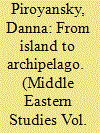

|
|
|
|
|
| Publication |
2012.
|
| Summary/Abstract |
This article circulates between three levels of inquiry and their interweaving - the personal, the local and the national. It draws on several historical dimensions - military, legal, political, sociological, architectural and cultural. In different ways, all these interlinked fields of human action are reflected in the private history of one particular house, built in the 1930s by Khalil Sakakini in Qatamon, Jerusalem. By examining both discursive and material aspects of the house and neighbourhood, the various mechanisms through which Arab property was brought, in the aftermath of the 1948 war, under Israeli control are revealed, some state-orchestrated and preconceived, others more spontaneous and based on individual and collective tendencies and preferences.
|
|
|
|
|
|
|
|
|
|
|
|
|
|
|
|
| 7 |
ID:
085336
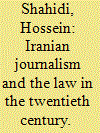

|
|
|
|
|
| Publication |
2008.
|
| Summary/Abstract |
Although the first Persian language newspaper was published in Iran 170 years ago, Iranian journalism is a twentieth century creation, indeed a product of the 1906 Constitutional Revolution. The press played a significant part in the revolution, especially by promoting the demand for the rule of laws enacted by parliament, rather than decrees issued by the king or the religious leaders. Once a constitution had been declared, many journalists felt relieved of all restrictions and engaged in bitter, personal attacks on their opponents, including the monarch and his family. Many papers also opposed a press law that was passed soon after the revolution, arguing that it was meant to suppress their newly-gained freedom. Five more press laws have been passed in Iran since then, but the debate over press freedom and the rule of law in the country does not appear to be anywhere near resolution.
|
|
|
|
|
|
|
|
|
|
|
|
|
|
|
|
| 8 |
ID:
110882
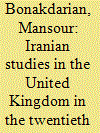

|
|
|
|
|
| Publication |
2010.
|
| Summary/Abstract |
This essay provides a general introductory survey of Iranian and Iran-related studies in the United Kingdom in the twentieth century (including languages, literature, and the arts), with a very brief preliminary foray into earlier Iran-related scholarship and wide-ranging imaginations of Iran in Britain and Ireland, as well as some concluding remarks on contemporary knowledge production about Britain in Iran. Among other themes covered in the essay are the varied contributions of non-Britons and non-Irish to Iran-related scholarship and imaginations in the United Kingdom, underscoring the overall transnational production, dissemination, reception, and utilization of knowledge (history, geography, archaeology, cultures, ethnography and anthropology, art and architecture, Iran-related Persian-language literatures and poetry, etc.). In particular, the essay highlights the contributions made by individuals from, and institutions in, the Indian subcontinent to "British" scholarship and knowledge about Iran.
|
|
|
|
|
|
|
|
|
|
|
|
|
|
|
|
| 9 |
ID:
097788
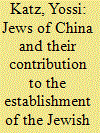

|
|
|
|
|
| Publication |
2010.
|
| Summary/Abstract |
This article deals with the contribution of Zionists throughout the world to the building of the National Home in Palestine, including the Zionist communities in the Far East - India and China. It examines the vast Zionist activity taking place in China, with the Zionists of China making a significant contribution, especially considering the small size of its Jewish community. In contrast to popular belief, in the period discussed in our research China was not distant and disconnected from the Zionist centres in Palestine and Europe. Written Zionist propaganda and Zionist representatives did not overlook China. The notable extent of donations and investments made by the Jews of China benefiting the National Home through the Jewish Colonial Trust, the Jewish National Fund, and the Foundation Fund is the result of two main factors: firstly, the economic strength of the community, especially the very wealthy Iraqi Jews, and secondly, the Zionist passion of the Chinese Jews. The Kadoorie family, whose donations assisted in purchasing land for the Hebrew University, the building of Ha'emek Hospital, and the establishment of the Galilee agricultural school, played a pivotal role. There is no doubt that Eliezer Kadoorie serving as head of the Zionist Organization in China as well as some of its institutions helped widen the circle of donors among upper and middle class Zionists in China, and shared in their prominent part in creating the Jewish National Home in Palestine.
|
|
|
|
|
|
|
|
|
|
|
|
|
|
|
|
| 10 |
ID:
076407


|
|
|
| 11 |
ID:
108257
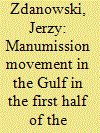

|
|
|
|
|
| Publication |
2011.
|
| Summary/Abstract |
Between 1906 and 1949, more than 950 slaves reported at the British agencies in Bahrain, Kuwait, Muscat, and Sharjah and asked for manumission. Their written statements prove that slavery was an important part of the local socio-economic system and that many slaves had for generations been bound with the same families of owners. The manumission movement was caused mainly by the collapse of the pearl industry in the Gulf in the 1920s and 1930s, but it was the psychological factor rather than the economic one which played the decisive role in slaves coming to a decision to run away from their master.
|
|
|
|
|
|
|
|
|
|
|
|
|
|
|
|
| 12 |
ID:
030828
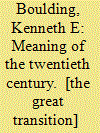

|
|
|
|
|
| Publication |
Madras, Higginbothams(P) Ltd., 1969.
|
| Description |
xvi, 199p.Hbk
|
| Series |
World Perspectives
|
|
|
|
|
|
|
|
|
|
|
|
Copies: C:1/I:0,R:0,Q:0
Circulation
| Accession# | Call# | Current Location | Status | Policy | Location |
| 012356 | 909.82/BOU 012356 | Main | On Shelf | General | |
|
|
|
|
| 13 |
ID:
111189
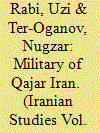

|
|
|
|
|
| Publication |
2012.
|
| Summary/Abstract |
The article examines the parameters of the irregular army in Qajar Iran, including its assembly, numbers, and provisions, as well as the army's organizational structure: its administration and the divisions of the ad hoc forces (provincial militia and tribal cavalry) and of the standing forces (the shah's bodyguard and artillery corps). Until the creation of the so-called regular army units in Iran at the beginning of the nineteenth century, the irregular army was regarded as the only military force in the service of the Qajar dynasty. Despite the existence of a "regular army," irregular forces, particularly tribal cavalry, continued to play a significant role in Iran's military system throughout the nineteenth century. By understanding the features of the irregular army-its role in Qajar society, its organizational and social structures, its ethnic composition, and other characteristics-we can better understand the character of the state itself.
|
|
|
|
|
|
|
|
|
|
|
|
|
|
|
|
| 14 |
ID:
145806
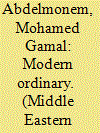

|
|
|
|
|
| Summary/Abstract |
Having experienced social and political structures of the nineteenth century Europe, western-educated Egyptian elite used public institutions to force new legislative structures and procedures that ruled out traditional housing forms and spatial systems. This essay detects direct and indirect impact of these changes that informed the spatial change of modern living in Egypt in the first quarter of the twentieth century. It offers analysis of socio-spatial practices and change in ordinary Cairenes’ modes of everyday living, using social routine and interaction to explain spatial systems and changing house forms during the first quarter of the twentieth century. In doing so, the essay utilized archival documents, accounts, formal decrees and novels of the time as well as conducting survey of house forms and spatial organizations in Old Cairo.
|
|
|
|
|
|
|
|
|
|
|
|
|
|
|
|
| 15 |
ID:
177268
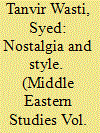

|
|
|
|
|
| Summary/Abstract |
Abdülhak Şinâsî Hisar, a famous writer whose active career may be said to have spanned over the first 60 years of the 20th century, is celebrated within Turkey for his inimitable prose style, steeped in nostalgia and expressed with great elegance and charm. His three short novels, based both on his childhood memories of life and on depicting characters he observed in an Ottoman capital that once had a sparkling civilization, and his biographies of major writers who were his friends, along with his essays on literary criticism and his prolific journalistic output, have assured him a place in the front rank of Turkish literary figures.
|
|
|
|
|
|
|
|
|
|
|
|
|
|
|
|
| 16 |
ID:
185873


|
|
|
|
|
| Summary/Abstract |
Persianate pasts die hard. Despite the birth of nation-states, advent of colonialism, rise of national literatures, and emergence of new global technologies, the Persianate connections defining the texts, idioms, and vocabularies that bound together large swaths of Islamic Eurasia throughout the early-modern period continued to shape and inflect cultural and literary production in the late-nineteenth and twentieth centuries. If the sixteenth to eighteenth centuries established the high-water mark of Persianate transregionalism, then the following two centuries were defined not so much by the undoing of this world in toto, but by its redeployment, reimagining, and regeneration in new cultural guises and (trans)national contexts. Exchanges across borders and languages helped to articulate new meanings for Persian texts. Educational practices in British India and journalistic ones in Central Asia provided venues for Persianate norms to be preserved, contested, and consecrated. The internationalism of the Soviet East created a new avenue for dynamic conversations about the nature of Persianate heritage and traditions. While new national practices and political ecologies were taking shape across Afghanistan, the Caucasus, Iran, and Central and South Asia, refashionings of Persianate pasts persisted. It is an exploration of such refashionings and the people who participated in them that form the contents of this special issue.
|
|
|
|
|
|
|
|
|
|
|
|
|
|
|
|
| 17 |
ID:
116413
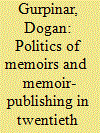

|
|
|
|
|
| Publication |
2012.
|
| Summary/Abstract |
Rather than investigating memoirs as sources for writing history, this article attempts to discuss the political and ideological meanings attributed to memoirs and how the memoir-publishing industry was utilized for such dispositions and proclivities in twentieth century Turkey. The article also examines how different social, ideological, and cultural milieus and circles were interested and fascinated with autobiographical writings and memoirs. The article concludes with examining how memoirs subsequently became a contested area and perceived as assets and instruments to be employed against political and ideological opponents with the booming interest in memoirs publishing that began in the 1990s.
|
|
|
|
|
|
|
|
|
|
|
|
|
|
|
|
| 18 |
ID:
139691
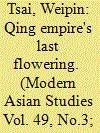

|
|
|
|
|
| Summary/Abstract |
The Great Qing Imperial Post Office was set up in 1896, soon after the First Sino-Japanese War. It provided the first national postal service for the general public in the whole of Chinese history, and was a symbol of China's increasing engagement with the rest of the globe. Much of the preparation for the launch was carried out by the high-ranking foreign staff of the Chinese Maritime Customs Service, an influential institution established after the first Opium War.
With a mission to promote modernization and project Qing power, the Imperial Post Office was established with a centrally controlled set of unified methods and procedures, and its success was rooted in integration with the new railway network, a strategy at the heart of its ambitious plans for expansion. This article explores the history of this postal expansion through railways, the use of which allowed its creators to plan networks in an integrated way—from urban centres on the coasts and great rivers through to China's interior.
|
|
|
|
|
|
|
|
|
|
|
|
|
|
|
|
| 19 |
ID:
131808
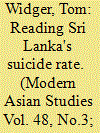

|
|
|
|
|
| Publication |
2014.
|
| Summary/Abstract |
By the final decade of the twentieth century, rates of suicide in Sri Lanka ranked among the highest in the world. However, in 1996 the suicide rate began to fall and was soon at its lowest level in almost 30 years. This decline poses problems for classic sociological theories of suicide and forces us to question some fundamental assumptions underlying social scientific approaches to the suicide rate. Drawing from sociological, medical epidemiological, historical, and anthropological secondary sources as well as 21 months of original ethnographic research into suicide in Sri Lanka, I argue that there are four possible readings of the country's suicide rate. While the first three readings provide windows onto parts of the story, the fourth-a composite view-provides a new way of thinking about suicide, not just in Sri Lanka but also cross-culturally. In so doing the paper poses questions for how the relationship between suicide and society might be imagined.
|
|
|
|
|
|
|
|
|
|
|
|
|
|
|
|
| 20 |
ID:
179072
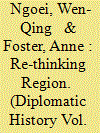

|
|
|
|
|
| Summary/Abstract |
More than twenty years ago, historian Robert McMahon pointed out that studies of U.S.-Southeast Asian relations with a “broad, regional focus” remain “surprisingly rare.”1 His observation came in the bibliographic essay accompanying his own contribution to this sparse field, and his book remains one of precious few examples. As Kenton Clymer demonstrates in the opening essay in this Roundtable, it remains the case that few scholars study U.S. relations with countries in Southeast Asia other than Vietnam and the Philippines. The U.S. war in Vietnam, and the immediate and lingering effects of U.S. imperialism in the Philippines rightly attract significant attention. Scholars have produced compelling and sophisticated works about these topics, and continue to do so. However, contributors to this Roundtable demonstrate that the region as a whole, as well as individual countries and topics within it, deserve more study.
|
|
|
|
|
|
|
|
|
|
|
|
|
|
|
|
|
|
|
|
|